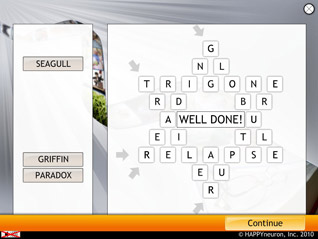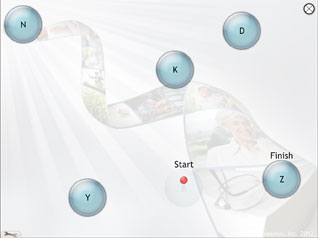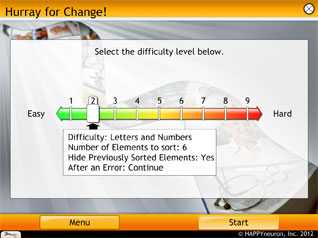Moderate to Mild Cognitive Impairment Program: Executive functions
Click to try FREE for 15-Days.
This module is specifically designed to train executive functions, including reasoning (capacity to make deductions from hypotheses) and strategy. It contains language-based tasks and visual activities.



Basketball in New York
The task
This exercise sounds easy enough but it is deceptively challenging! The patient will see a first line of three hoops with colored basketballs inside. In the second line, he will have to mentally determine the number of basketball moves required to reach the same configuration (same color in the same hoop) as the first line of hoops.
What it trains
This is a problem-solving type of exercise. The user needs to mentally plan his action, strategize his next move, go back on the wrong moves and build his own reasoning in a concentrated way. This exercise trains also his visual mental imagery as he can't move the basketballs with the mouse. All the possible actions must be visualized in his mind.
Parameters
In this program, 9 levels have been specially selected to ensure an easy start and grant a regular progression.






Decipher
The task
In this task, the patient is asked to decipher some famous quotations where the letters have been replaced, either by other letters or by symbols. To make the exercise easier, each letter is always replaced by the same letter or symbol. Cracking these secret codes is perfect practice if a person likes mysteries!
What it trains
This deciphering exercise trains the user's concentration and his capacity to deduce what is not directly written by linking the various pieces of information he is given and his own knowledge of language (spelling, grammar rules, and letter frequency). This will help him build a coherent quotation. This task also requires the collaboration of various cognitive skills: concentration, language (spelling, grammar rules, letter frequency), logic, and the capacity to make deductions from hypotheses.
Parameters
In this program, 9 levels have been specially selected to ensure an easy start and grant a regular progression.






The Towers of Hanoi
The task
In this exercise, the patient must configure colored rings on a series of pegs in order to match a target. There are some rules to respect: He can move the top-most ring on each peg to another peg, but he can only move one ring at a time and he can never put a larger ring on top of a smaller ring. From time to time, a given peg may not hold any rings: he may move any available ring on to an empty peg.
What it trains
It is widely acknowledged in neuroscience and psychology research that problem-solving abilities rely not only on language-analytical reasoning but also temporal-spatial design skills that we use to visualize some problems.
Parameters
In this program, 9 levels have been specially selected to ensure an easy start and grant a regular progression.






Writing in the Stars
The task
Heavenly inspiration is required for this new twist on the old cross-word puzzle. The user is given a list of nine words. Only six of them can be used to fill the empty squares and connect with each other to form the six-point star.
What it trains
Making travel plans, keeping track of various appointments, engaging in group dynamics at work or at a social event, to evaluate a colleague's ideas and then to reflect on the work are all examples of executive functioning. Indeed, this exercise aims at training the patient's capacity for logical reasoning. In order to determine which 6 words to choose from the list of nine, he has to try a number of logical combinations to find which positions of letters are common to two or three words.
Parameters
In this program, 9 levels have been specially selected to ensure an easy start and grant a regular progression.






Hurray for Change!
The task
There are two tasks to this exercise. In the first part, series of 4 to 16 letters or words must be linked in alphabetical order. The second part demands to alternately sort two series of items.
What it trains
In addition to mental flexibility and strategy skills, this exercise requires concentration and visual and spatial exploration skills. Visual and verbal working memory skills are also stimulated, as well as language skills which are necessary when letters or words are involved. This game develops cognitive flexibility, that is, the ability to engage in one activity, disengaging andthen re- engaging. In real life, such a situation can occur when being engrossed in paperwork, suddenly the phone rins and must be answered, after which the person has to get back to their original task. The skills called upon in this game are constantly used in our daily lives. Another example is scanning for a name on a list or scanning a monitor for airline flight departures or arrivals screen. Further, in everyday life, one may use executive functions when reorganizing files or preparing the house for the holidays by simultaneously cooking various dishes when everything has to be ready at a different time!
Parameters
In this program, 9 levels have been specially selected to ensure an easy start and grant a regular progression.






The Right Count
The task
In this exercise, the patient is asked to identify and sort out even and odd numbers in ascending or descending order.
What it trains
This exercise mainly involves executive functioning skills. It also requires both visual scanning, spatial exploration of the grid and a high degree of concentration. Memory also plays a role here as we utilize mental strategies that involve the storage and retrieval of information when recalling the location on the grid of numbers scanned earlier. Finally, you will also use your numerical processing skills as you order the numbers in ascending or descending sequence.
Parameters
In this program, 9 levels have been specially selected to ensure an easy start and grant a regular progression.



Click to try FREE for 15-Days.
